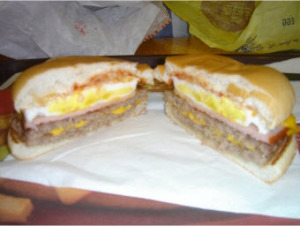4 Reasons Why Fast Food Secret Menu Items Are Good For Business

The Mc10:35 in all its eggy, burgery glory.
Whether it’s wedging a grilled chicken sandwich inside a double cheeseburger or stuffing a quesadilla into a burrito, many secret menu items are really just mash-ups or alterations of existing offerings, often created by hungry and imaginative diners (or franchisees) in the spur of the moment. But when these items start getting repeat orders and spreading to other stores, a true secret menu is created.
CREATING A MYTHOLOGY
An effective secret menu item need not be a real secret at all. It merely has to have the appearance of being special.
In-N-Out Burger might have the least-secret secret menu in the fast food business. Heck, you can find most of the so-called secret offerings on the company website. But the mere existence of this not-so-secret menu has helped create a mythology around these particular items.
I remember my first visit to L.A. several years back. As we drove up to an In-N-Out for lunch, the friend I was staying with coolly asserted, “You don’t order off the regular menu,” the same as someone in the Hamptons would glare at me for wearing white in October.
Would that In-N-Out 3X3 be any less tasty or calorific if it were listed on the actual menu at the restaurant? Not likely. But would people speak about it with such reverence? Doubtful.
ENGENDERING FANDOM
In addition to creating an aura of special-ness about a food item that may not merit such affection, having secret menu items — or allowing customers to fully customize their orders — only helps to make fans out of the brand.
“They feel kind of a personal connection to the restaurant,” one restaurant industry expert explained in a recent interview. “they feel they know something that maybe not everybody else does.”
FREE PUBLICITY
A number of these fast food fans will take photos of their food, or share their stories about trying to hunt down some elusive secret menu item mentioned deep in the comments of a Reddit thread.
In fact, Fast Company’s Mark Wilson recently chronicled his effort to purchase a whispered-about “quesarito,” the above-referenced burrito wrapped around a quesadilla. Sure, it’s the kind of thing that Chipotle could add to its menu, but then there wouldn’t be a lengthy article on a popular website about the 1,500-calorie gut-bomb and how Wilson eventually just had to talk an employee into making one for him.
Chipotle comes out of the story looking good, all while scoring free publicity, including the few sentences I’ve written here.
SECRET MENU ITEMS CAN LOOK UGLY
Beyond the marketing value and word-of-mouth that a good secret menu item brings, it also gets fast food companies around one common complaint — that fast food looks like crud and almost never resembles the food in the ad photos.
In fact, we don’t know how one would go about making a Mc10:35 — which combines an Egg McMuffin with a McDouble — into something that looks pretty on a poster. But McDonald’s doesn’t need to worry about that, because anyone who is ordering one of these fast food Frankensteins isn’t doing it because it looks nice on a billboard.
Additionally, since the Mc10:35 isn’t listed on the menu — and is usually assembled by the customer instead of a McDonald’s employee — the restaurant doesn’t need to worry about dealing with calorie counts and nutritional info. Anyone who wants to figure that out can do the math themselves using available info.
As always, we’re looking for the latest and greatest in secret menu items, so feel free to tell us about your latest creations and discoveries at tips@consumerist.com.
Want more consumer news? Visit our parent organization, Consumer Reports, for the latest on scams, recalls, and other consumer issues.

